Research - (2021) Volume 9, Issue 2
Awareness of Smoking Habits among College Students
A Akshaya, Dhanraj Ganapathy* and Keerthi Sasanka
*Correspondence: Dhanraj Ganapathy, Department of Prosthodontics, Saveetha Dental College and Hospitals, Saveetha Institute of Medical and Technical Sciences (SIMATS), Saveetha University Tamilnadu, India, Email:
Abstract
Smoking is one of the common recreational drug uses. Tobacco smoking habit has spread across the world, and is a significant cause of mortality and morbidity. Smokers are more likely to develop many deadly diseases such as cancer and other types of respiratory diseases. Tobacco smoking-related diseases have been shown to kill around half of long-term smokers compared with the overall mortality levels faced by non-smokers. A cross-sectional study was conducted by circulating the self-designed questionnaire among 100 college students. The questionnaire was designed to assess the data’s on demographics, smoking prevalence, smoking related knowledge and attitudes and health effects due to smoking habits. The survey was conducted through an online setting through a survey planet app. The responses from the study were analysed and represented in pie charts. The findings were 68% of individuals aware of the complications of smoking. Around 30% of individuals felt that the habit of smoking is greatly influenced by friends and stress. 92% of individuals felt that smoking in public places is an offence. 63% of individuals agreed that smoking affects appetite. The study concludes that students are well aware about smoking habits and its ill effects which cause major complications in their health. In addition, collaborative and more comprehensive anti-tobacco efforts are important to curb the tobacco epidemic.
Keywords
Smoking habits, health effects, Online study
Introduction
Smoking is a major public health problem throughout the world. It constitutes the single leading cause of preventable death and disease [1]. In 1998, the worldwide mortality rate from tobacco-related diseases reached 4 million per year and is expected to reach 10 million per year by 2030. This is more than the estimated overall reported deaths from tuberculosis, malaria, maternal and other childhood conditions [2]. Smokers are at high risk of developing many physiological problems, as smoke inhalation inherently causes challenges. Tobacco contains nicotine, a type of alkaloid which can cause both stimulating and sedative effects [3]. Smoking causes minor defects like cough, wheezing, lung irritabilities and also major diseases like chronic obstructive pulmonary disease (COPD), emphysema and lung cancer [4]. Smoking has also been associated with oral complications, including dental caries, dental implant failure, premalignant lesions, and cancer. Smoking can affect immune-inflammatory processes that may increase susceptibility to infection; it may alter oral mycobiota and may encourage oral cavity colonization with fungi and pathogenic molds [5].
Chronic tobacco addiction in any form accounts for 1 in 10 deaths in adults, with one person dying every 6 seconds. Tobacco remains one of the most popular types of substance abuse, given its deleterious effects on life and health. More than 80 per cent of the estimated 1 billion smokers worldwide live in emerging or underdeveloped nations. Prevalence of smoking among women is comparatively less than male [6] in developing countries due to their cultural and religious norms. In fact women who smoke will evidence the gender specific health consequences, like reproductive defects [7]. On comparing the prevalence rate of tobacco smoking among rural and urban areas in southern india, (23%) prevalence is seen in rural areas followed by semi urban and (19.4%) seen in urban areas [8].
According to the World Health Organization (WHO), India accounts for 12 percent (about 120 million) of global smokers with the highest number of cigarette smokers registered in Jammu and Kashmir State [9]. Students had attributed many reasons to the use of tobacco products. These are the perceptions that smoking improved your appearance, relieved boredom and helped alleviate tension [10]. Previously our department has published extensive research on various aspects of prosthetic dentistry ‘Evaluation of Corrosive Behavior of Four Nickel– chromium Alloys in Artificial Saliva by Cyclic Polarization Test: An in vitro Study’, 2017 [11-21], this vast research experience has inspired us to research about the awareness of smoking habits among college students.
Materials and Methods
A self-designed questionnaire containing 15 questions was prepared and circulated to college students across Tamil Nadu through an online survey link. The survey included both male and female between the age group of 18 to 25 years. About 100 students participated in the study. The type of research was questionnaire study and the sampling method was simple random sampling. The questions assessed the awareness levels of smoking habits and its ill effects. Exclusion criteria were people of age group above 25 years. Statistics were analysed from the data collected. The responses and findings from the study were represented in pie charts. The Sampling method used was Simple randomized sampling method, the Independent variables are college students and Depedent variables are Knowledge, awareness, age and sex, the Statistics used were Descriptive statistics.
Results and Discussion
In this cross sectional study conducted among college students, we found that (67.2%) of individuals were well aware of the complications like emphysema (Figure 1). This finding was supported by [22], in which the rate of smokers experiencing symptoms of COPD was higher than the non-smokers. Around (12%) of individuals participated in this study felt that smokers have high risk of developing lung cancers [23]. In our study (67%) of individuals responded that they won’t feel free to smoke in public places (Figure 2). This finding was supported by [24], in which (84%) of current smokers replied that they avoid smoking in public places.
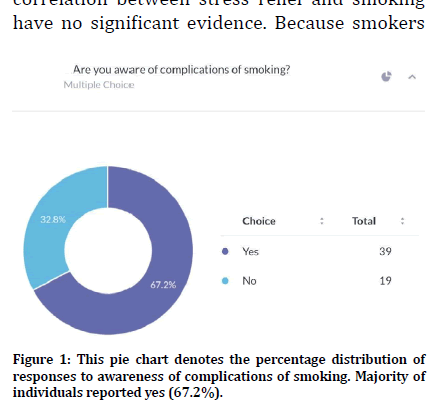
Figure 1. This pie chart denotes the percentage distribution of responses to awareness of complications of smoking. Majority of individuals reported yes (67.2%).
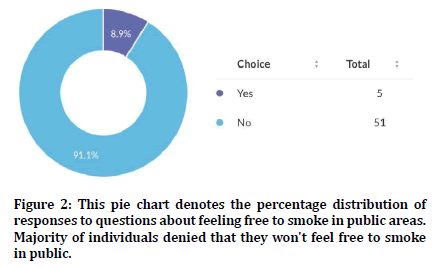
Figure 2. This pie chart denotes the percentage distribution of responses to questions about feeling free to smoke in public areas. Majority of individuals denied that they won't feel free to smoke in public.
In our study, (63%) of individuals reported that smoking habits will affect appetite (Figure 3). Nicotine consumption causes more energy expenditure, which results in sudden weight loss complications evidenced in smokers [25]. In our study, (30.8%) of individuals reported that stress and friends are influential factors to start smoking (Figure 4). This finding was supported by [26], in which (35%) of participants felt smoking starts due to having smoker friends and also (16.9%) of individuals reported that due to stress and life difficulties. In our study, (55%) of individuals reported that smoking doesn’t relieve stress (Figure 5). Nicotine in cigarettes usually increases stress and anxiety levels, but correlation between stress relief and smoking have no significant evidence. Because smokers believe that smoking reduces stress, which is not yet proven physiologically.
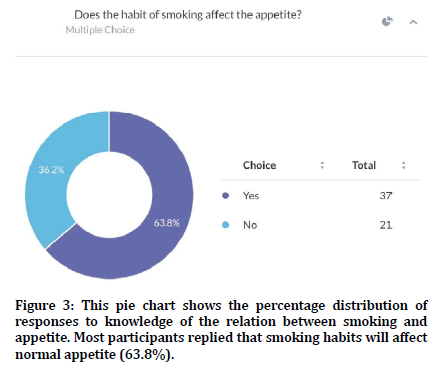
Figure 3. This pie chart shows the percentage distribution of responses to knowledge of the relation between smoking and appetite. Most participants replied that smoking habits will affect normal appetite (63.8%).
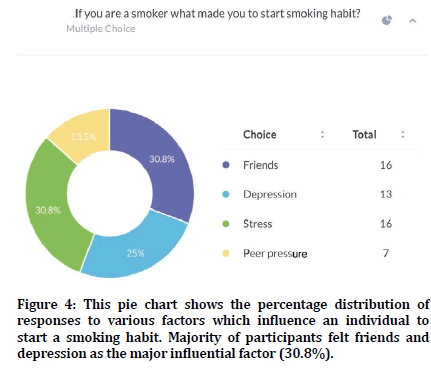
Figure 4. This pie chart shows the percentage distribution of responses to various factors which influence an individual to start a smoking habit. Majority of participants felt friends and depression as the major influential factor (30.8%).
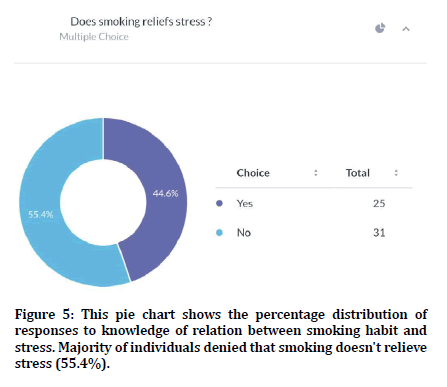
Figure 5. This pie chart shows the percentage distribution of responses to knowledge of relation between smoking habit and stress. Majority of individuals denied that smoking doesn't relieve stress (55.4%).
In our study, (69.6%) of students replied that they haven’t visited rehabilitation centers (Figure 6). A survey conducted in saudi Arabia among medical students, they found that (51%) of students agreed to quit smoking [27]. In our study, (61%) of individuals replied that mild smoking is not hazardous (61%) (Figure7). In a survey conducted among female students in Saudi Arabia university only (2.7%) of individuals replied as not hazardous [28].
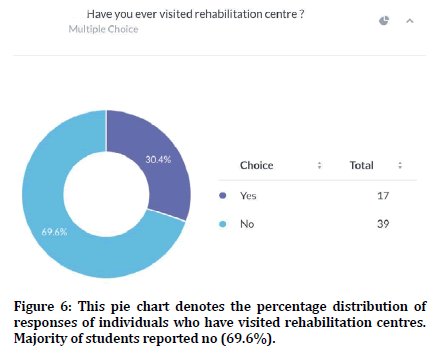
Figure 6. This pie chart denotes the percentage distribution of responses of individuals who have visited rehabilitation centres. Majority of students reported no (69.6%).
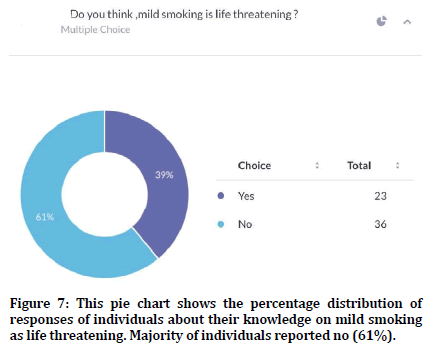
Figure 7. This pie chart shows the percentage distribution of responses of individuals about their knowledge on mild smoking as life threatening. Majority of individuals reported no (61%).
Despite the many bans, European countries still hold 18 of the top 20 spots, and according to the ERC, a market research firm, the heaviest smokers come from Greece, with an average of 3,000 cigarettes per person in 2007. Smoking rates in the developed world have decreased or declined, but continue to rise in developing countries [29]. Although there was a moderate level of awareness among the students and a good amount of knowledge about the health effects of smoking, this did not affect their smoking behavior. The backbone of health education remains to inform the public, particularly such a highly educated and influential group, about the health consequences of smoking. Better health knowledge alone, however, cannot curb the smoking epidemic, especially since the habit develops in adolescents when long-term risk may be of little concern and considered to be far away in future. The limitations of the present study were that only a homogeneous limited population is involved. Surveys on a larger scale will give precise findings. This research may not actually be reflective of young adults because it anticipates a socio-economic gradient between university students and the general population.
Limitations
The limitations of our study include limited sample size, Homogenous population and regionalism. Overcoming which we can get more accurate and precise findings.
Future Scope
The present study indicated the need of creating more awareness through programmes or other means among general population
Conclusion
Almost all of the respondents were well aware of the consequences of smoking habits and this habit was not uncommon among students. Even though the awareness rate was found to be moderate, further awareness and prevention programs need to be conducted by the government. We suggest that findings from our study should be taken into account in anti-smoking program design. Our study gives positive hope that younger generations are well educated about smoking habits.
Acknowledgement
This research was done under the supervision of the department of research of Saveetha Dental College and Hospitals. We sincerely show gratitude to the corresponding guides who provided insight and expertise that greatly assisted the research.
Conflict of Interest
The author has none to declare.
References
- Azhar A, Alsayed N. Prevalence of smoking among female medical students in Saudi Arabia. Asian Pacific J Cancer Prevention 2012; 13:4245–4248.
- World Health Organization. WHO global report on trends in prevalence of tobacco smoking 2015.
- Benowitz NL. Nicotine addiction. New England J Med 2010; 362:2295–2303.
- Sikjær MG. Lack of awareness towards smoking-related health risks, symptoms related to COPD, and attitudinal factors concerning smoking: an Internet-based survey conducted in a random sample of the Danish general population. Eur Respir 2018; 5:1506235.
- Monteiro-da-Silva F. Characterization of the oral fungal microbiota in smokers and non-smokers. Eur J Oral Sci 2013; 121:132–135.
- Lopez AD, Collishaw NE, Piha T. A descriptive model of the cigarette epidemic in developed countries. Tobacco Control 1994; 3:242.
- General USS. Youth violence: A report of the surgeon general. Psychiatric Services 2001; 52:399.
- Chockalingam K. Prevalence of tobacco use in urban, semi urban and rural areas in and around Chennai City, India. PloS One 2013; 8:76005.
- Gajalakshmi V, Kanimozhi CV. A survey of 24,000 students aged 13–15 years in India: Global youth tobacco survey 2006 and 2009. Tobacco Use Insights SAGE Publications 2010.
- Hayes J, Koo J. Psoriasis: Depression, anxiety, smoking, and drinking habits. Dermatol Therapy 2010; 23:174–180.
- Begum R, Ariga P, Jain AR. Evaluation of corrosive behavior of four nickel–chromium alloys in artificial saliva by cyclic polarization test: An in vitro study. World J Dent 2017; 8:477-482.
- Ganapathy DM, Kannan A, Venugopalan S. Effect of coated surfaces influencing screw loosening in implants: A systematic review and meta-analysis. World J Dent 2017; 8:496–502.
- Jain AR. Clinical and functional outcomes of implant prostheses in fibula free flaps. World J Dent 2017; 8:171–176.
- Jain AR. Prevalence of partial edentulousness and treatment needs in rural population of South India. World J Dent 2017; 8:213–217.
- Ranganathan H, Ganapathy DM, Jain AR. Cervical and incisal marginal discrepancy in ceramic laminate veneering materials: A SEM analysis. Contemporary Clin Dent 2017; 8:272–278.
- Ariga P. Determination of correlation of width of maxillary anterior teeth using extraoral and intraoral factors in Indian population: A systematic review. World J Dent 2018; 9:68–75.
- Gupta P, Ariga P, Deogade S. C. Effect of monopoly-coating agent on the surface roughness of a tissue conditioner subjected to cleansing and disinfection: A contact profilometric study. Contemporary Clin Dent 2018; 9:S122–S126.
- Anbu RT. Comparison of the efficacy of three different bone regeneration materials: An animal study. Eur J Dent 2019; 13:22–28.
- Ashok V, Ganapathy D. A geometrical method to classify face forms. J Oral Biol Craniofac Res 2019; 9:232–235.
- Duraisamy R. Compatibility of nonoriginal abutments with implants: Evaluation of microgap at the implant-abutment interface, with original and nonoriginal abutments. Implant Dent 2019; 28:289–295.
- Varghese SS, Ramesh A, Veeraiyan DN. Blended module-based teaching in biostatistics and research methodology: A retrospective study with postgraduate dental students. J Dent Educ 2019; 83:445–450.
- Godtfredsen NS. Risk of hospital admission for COPD following smoking cessation and reduction: A danish population study. Thorax 2002; 57:967–972.
- Chen LS. How are lung cancer risk perceptions and cigarette smoking related?-testing an accuracy hypothesis. Translational Cancer Res 2016: S964–S971.
- Tessier JF. Smoking behaviour and attitudes of medical students towards smoking and anti-smoking campaigns: A survey in 10 African and Middle Eastern countries. Tobacco Control 1992; 1:95.
- Zoli M, Picciotto MR. Nicotinic regulation of energy homeostasis. Nicotine Tobacco Res 2012; 14:1270–1290.
- Al-Turki YA. Smoking habits among medical students in central Saudi Arabia. Saudi Med J 2006; 27:700–703.
- Maziak W. Characteristics of cigarette smoking and quitting among university students in Syria. Preventive Med 2004; 39:330–336.
- Jarallah JS. Prevalence and determinants of smoking in three regions of Saudi Arabia. Tobacco Control 1999; 8(1): 53–56.
- Lal B. ‘Smoking-Hazardous to our health:“an overview”’, PharmaTutor. PharmaTutor Edu Labs. 2014; 2:141–146.
Author Info
A Akshaya, Dhanraj Ganapathy* and Keerthi Sasanka
Department of Prosthodontics, Saveetha Dental College and Hospitals, Saveetha Institute of Medical and Technical Sciences (SIMATS), Saveetha University Tamilnadu, Chennai, IndiaCitation: A. Akshaya, Dhanraj Ganapathy, Keerthi Sasanka, Awareness of Smoking Habits among College Students, J Res Med Dent Sci, 2021, 9 (2): 309-313.
Received: 23-Sep-2020 Accepted: 15-Feb-2021
